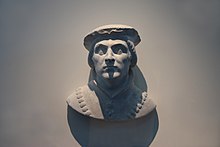You can help expand this article with text translated from the corresponding article in French. (July 2012) Click [show] for important translation instructions.
|
Humbert I of Viennois (c. 1240 – 12 April 1307) was baron of la Tour-du-Pin and then also became, by his marriage, dauphin of Viennois. He was the son of Albert III, baron of la Tour-du-Pin, and of Béatrice de Coligny[1] (herself the daughter of Hugh I, lord of Coligny and of Béatrice d'Albon, dauphine of Viennois).

In 1294, Humbert became a vassal of King Philip IV of France in exchange for £500 annual pension, which would give impetus to the acquisition of the Dauphiné, by King Philip VI of France, fifty years later.[2]
In September 1273 Humbert married Anne of Burgundy[3] (daughter of Guigues VII of Viennois) – their nine children were:
- John II (1280 † 1319), succeeded his father as dauphin of Viennois
- Hugues († 1329), baron de Faucigny
- Guigues († 1319), seigneur de Montauban.
- Alix (1280 † 1309), married John I (1275 † 1333), count of Forez in 1296
- Marie, married Aymar de Poitiers-Valentinois
- Marguerite, married Frederick I († 1336), Marquess of Saluzzo in 1303
- Béatrice (1275 † 1347), married Hugh I of Chalon-Arlay in 1312
- Henri (1296 † 1349), bishop of Metz
- Catherine († 1337), married Philip of Savoy (1278 † 1334), count of Piedmont and prince of Achaea in 1312[4]
References
editSources
edit- Cox, Eugene L. (1967). The Green Count of Savoy. Princeton, New Jersey: Princeton University Press. LCCN 67-11030.
- Cox, Eugene L. (1974). The Eagles of Savoy: The House of Savoy in Thirteenth-Century Europe. Princeton University Press.
- Cox, Eugene (1999). "The Kingdom of Burgundy, the lands of the house of Savoy and adjacent territories". In Abulafia, David; McKitterick, Rosamond (eds.). The New Cambridge Medieval History. Vol. 5, C.1198–c.1300. Cambridge University Press.
Wikimedia Commons has media related to Humbert I, Dauphin of Viennois.